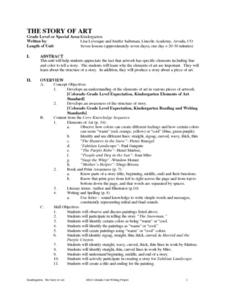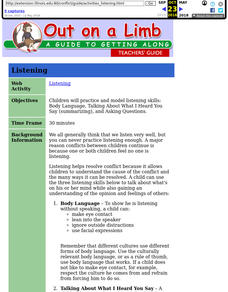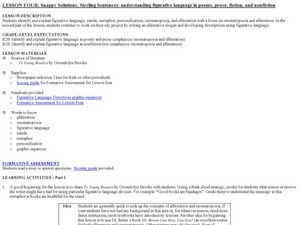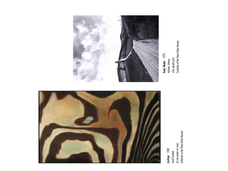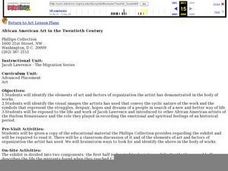Curated OER
Why Do Art?
Students examine the purposes of art and view examples of art created by artists, designers, and craftspeople. They write a report describing the various purposes for creating works of art.
Curated OER
The Story of Art
Students canvass the important elements of art in the seven lessons of this unit. Story structure and in particular, color is perceived as essential to the development of the idea of a picture.
Curated OER
Visual Arts: Art in Public Places
Students create 3 dimensional art. In this sculpture lesson, students collect objects that represent their community's values to include in a 3 dimensional sculpture. Students write a paragraph explaining the chosen theme of their...
Curated OER
Greek Mythology: Cultures and Art
Students examine literary arts. For this Greek mythology lessons, students read Greek myths and select characters from the myths to study. Students create watercolor illustrations of the characters, write short stories about the...
Curated OER
Vessel Based On Art History Research
Young scholars create a functional ceramic vessel inspired by the work of another artist from art history. A number of art history resources be provided as well as the Internet. They research outside of class for the written report.
Curated OER
Art and Literature: What's the Point?
Eleventh graders analyze the social/political purpose(s) of art and literature. They create written and visual texts that bring attention to a social/political concern. Presentation and discussion of art and literature in connection with...
Curated OER
Shapes in Art, Shapes in Body
Students explore body movement. In this shapes and dance lesson, students demonstrate body movements and positions that resemble simple shapes. Students read I Spy Shapes in Art by Lucy Micklethwait and choose shapes from the book to...
Curated OER
Story Setting - The Art Lesson by Tomi dePaola
Students read the book The Art Lesson by Tomi dePaola and analyze the story. In this setting lesson, students discuss the importance of the setting and how it helps us understand the story. Students answer questions and chart their...
Curated OER
Enough to Make Your Head Spin
Students investigate the world of nonverbal communication by analyzing body language around the world. In this cultural communication instructional activity, students research the Bulgarian language and how we could easily misinterpret...
Curated OER
Northwest coast Button Blanket Art
Learners explore artistic design by viewing video clips on the Internet. In this blanket making activity, students view tutorial videos in which they discover the creative process in button blanket designing. Learners create their...
Curated OER
A Creative Presentation
Bring writing to life with this lesson in which elementary and middle schoolers create a display of the imagery they identify in a series of Gary Paulsen books. They read the suggested materials, identify imagery and descriptive...
Curated OER
Narratives
Add to the narrative writing experience. Elementary or middle school writers listen to the teacher read a descriptive passage, then reread the same passage silently. They highlight sensory details and figurative language, then orally...
Curated OER
A Guide to Getting Along: Listening
Here is an effective way to have your charges practice and model important listening skills. After a short review of effective active listening concepts, such as using body language, summarizing what the other person said, and asking...
Curated OER
Rest in Peace, Maniac Magee
Scholars read Maniac Magee and create epitaphs for each of the major characters using precise words reflecting the individual characters personality and nature. They will learn what an epitaph is and practice writing their own. They can...
Curated OER
Reading Examples
Young writers read excerpts from Gary Paulsen's memoir to identify figurative and literal language that contain sensory details. They determine which selections are examples of sensory language and fi the language is used literally or...
Curated OER
Logs, Charts, and Journals: What's On Your Plate?
Have your writers identify and use words that appeal to the senses. They create a chart of sensory words and record some of their favorites, then write a journal entry in which they describe eating at a restaurant using sensory details....
Curated OER
English is So Tricky
In this homophone worksheet students read examples of either homophones, or words spelled the same with different meanings. Students answer 8 questions on this challenging worksheet.
Curated OER
Snappy Solutions, Sizzling Sentences
An examination of the figurative language in Gwendolyn Brooks’ To Young Readers challenges your writers to think about the richness of language. Ask your class why Brooks says, “Good books are bandages.” This discussion of alliteration,...
Curated OER
Metaphor
High schoolers identify the distinction between literal and figurative language with a focus on metaphors. They complete a metaphor analysis chart, then practice expanding metaphors by composing their own comparisons of elements of the...
Curated OER
Painting Modern Life
Examine three Cubism art pieces by Pablo Picasso and Georges Braque with your students. They will research how Cubism was advanced due to Picasso and Braque. and then compare and contrast Cubist works through image based discussion. Your...
Curated OER
Shapes and Patterns in Art and Oceans
First graders draw, cut out, and design their own fish shapes by cutting out shapes and putting them together. In this shapes and patterns worksheet, 1st graders also construct a stamp and print patterns with stamps to repeat a...
Curated OER
Compare and Contrast Art
Practice the skill of compare and contrast. First, show learners the different pairs of artwork in the project packet (included). Then, each learner chooses one of the pairs and finds the similarities and differences between the...
Curated OER
African American Art in the Twentieth Century
Students create a poster and paper describing the importance of African American History Week after a visit to the Phillips Collection in Washington DC.
Curated OER
BBC Learning English - Keep Your English Up to Date
That’s showbiz! Clipping is the term used to describe one type of abbreviation of words. After listening to a talk by Professor David Crystal about this particular way English language changes, pupils supply the shortened, or clipped,...
Other popular searches
- English Language Arts
- English Language Arts Exam
- English Language Arts Games
- Deaf English Language Arts
- English Language Arts Music
- English Language Arts Heroes
- English Language Arts Skills
- English Language Arts Grade 3
- English/language Arts
- English Language Arts Poetry
- English Language Arts Rating=3
- English Language Arts Unit Sc



